Greetings, it is Fun and games time, talking about, of all things, 4K resolution issues as they relate to projectors. I hope you all enjoy this blog about FauxK vs 4K, and it all means, especially when it comes home theater and home entertainment projectors.
This blog follows up an article I wrote about 2 years ago):
FauxK vs 4K.
Should anyone care, I didn't invent the term FauxK to describe some projectors. The first usage I've found goes back to 2010, on another AV site. That was many years before the "4K UHD" projectors or 4K consumer content appeared.
Using pixel shifting to claim higher resolution, I (and others) figure the manufacturers almost begged for us to feel the need to shout FauxK. Some in the industry, don't think "4K UHD" should have 4K in its name at all, if it was just a standard called UHD, there wouldn't be any of the fuss. But that notwithstanding, the amusing part is:
I sure get a whole lot of complaints from various projector manufacturers, that offer "4K UHD" and/or 1080p pixel shifters that can work with 4K content because I've referred to them as FauxK. (Hey, calling them FauxK has been fun, and in this world of sound bite attention spans - it gets immediate attention).
You would think from some of those manufacturers, that my using the term FauxK is worse,or at least controversial, than (dare I say it); kneeling for the National Anthem, before a game. Ouch!

Jennifer Lawrence in Passengers - 4K HDR content, BenQ HT2550 projector - $1499
We come from a history of previous resolutions including HD resolutions not specifying actual resolution: ie. VGA (640x480), Standard HD was/is used for 720p, while FHD or Full HD is used to describe 1080p but no one put "1.3K" or "2K" in front of HD, so what was wrong with just calling this "new" resolution, simply UHD for Ultra High Definition (which is what UHD stands for). But no, the CTA - the same, wonderful folks that put on the Consumer Electronics Show, created the 4K UHD definition and - short version - define it as being able to put 8.3 million pixels on the screen. It's the type of pixels though, that create the confusion and controversy.
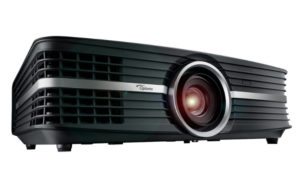
The $2499 Optoma UHD65 home theater PJ has 2716 x 1528 x 2 resolution, (medium sized pixels) pixel shifting to get to generate 8.3 million pixels - 4K UHD.
At least 3 different size pixels are currently being used by folks touting "4K."
Now for the past few years, I've used these terms:
4K, True 4K, Native 4K - to describe projectors that use panels or chips that have either 3840x2160, or 4096x2160, or 4096x2400 native resolution without overlapping pixels. All I call true / native 4K projectors meet the definition of 4K UHD. I'm starting to see some manufacturers using pixel shifting also starting to call theirs "true 4K." I don't approve.
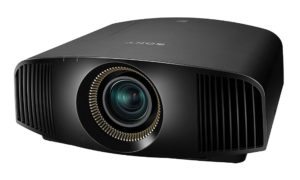
Sony VW385ES: $7999: True native 4K (smallest pixels), great color, v. good black levels, energy efficient, quiet - what's not to like?
Anything that overlaps pixels, and puts 8.3 million of the little suckers on a screen is defined as 4K UHD, but the pixels are much larger. TI has two different 4K UHD chips - 2716 x 1528 pixels times 2 (pixel shifting one time to double the pixels). Do the math, you get 8.3 million. Their other chip, brand new, is - oh no - 1920x1080 times 4 (shifting pixels 3 times).
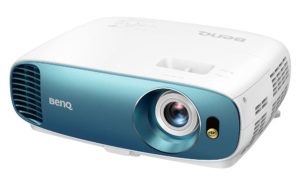
$1499 BenQ TK800 bright room projector, 4K UHD 1920x1080x4 (larger pixels). 3000 lumens
The first example uses pixels that are twice the size (in area) of "native" 4K. The second example, uses pixels that are four times the size of native 4K.
Obviously, no matter how much fancy processing you throw at this issue, Two projectors otherwise identical, will produce a sharper, more detailed image with the smaller pixels. (I'm just waiting for a 1280x720 times 9 - shifting 8 times), why not. True, those pixels will be about the size of a bowling ball compared to true 4K being about the size of a baseball (just a guess, don't start doing the math). Even 2716x1528x2 would have pixels roughly the equivalent to a soft ball, vs that same hard ball.
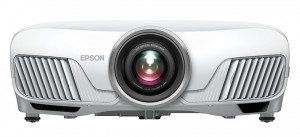
$2300 street the 4K capable Epson HC5040UB is a 1080p x 2 pixel shifter, (larger pixels) with serious black levels, lots of features.
Now there are other pixel shifters, notably from JVC and Epson - those are 1920x1080 times 2 - so that's only 4.15 million pixels not 8.3 so those don't qualify as 4K UHD ,but their pixel size is the same as the smaller 4K UHDs they just aren't overlapping as many times. Understand, all of these - native and pixel shifters, do support 4K content, no matter how they process and project it. That's why I also like the phrase 4K Capable, which I will continue to use (until it's time to start talking "8K Capable).
OK, so once again, I've defined what's going on.
Why is FauxK dead? Well it's only "mostly dead" (a quick shout out to all you
The Princess Bride fans).
Going forward I'm going to avoid using the FauxK term. Mind you, it hasn't cost us any biz, so I'm not feeling threatened by those manufacturers, despite their kvetching. (One major advertiser - in showing their displeasure, did say to me in the past few months something like: "Despite your continued use of FauxK to describe our projector(s), we're still going to renew our advertising with you." (Well, that made me feel good!)
But at CES I was having a calm discussion of 4K UHD, 4K and specifically, the term FauxK. There I heard the best argument for not using the term, from one of the folks at the Texas Instruments suite at the show.
The point made was it's not about whether FauxK is a bad or inaccurate term to use, technically, but what the impact, in today's sensitive world, might be on peoples' (home theater type peoples) perception. And here is the example loosely paraphrased by me.
It's your anniversary. You want to show your love and appreciation for your "better half," so you buy a very nice piece of jewelry, and present it - this way: ...
I bought you this lovely Faux-diamond.
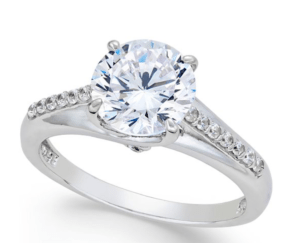
A lovely, $31 Cubic Zirconia ring. It sparkles, but not like "the real thing", a.k.a. a diamond
OK, you see the damage done from describing it that way:
"What, I'm not worth a real diamond? You bought me a fake?"
The point being, that I could be turning a lot of folks off to a solution - a non-native 4K projector - that might be right for them, because of the connotation that comes with "Faux."
Now, I always go to great lengths to describe the various differences in these resolutions as I have above, but
I certainly don't want to turn people off due to a "sound bite" when the truth is, I might be talking about the best solution for the bucks, because they never got farther than the sound bite.
So no more FauxK for me. I'll keep on explaining the many variations of handling 4K content, and which projectors are better, you'll just have to read more than "this one's a FauxK projector" to get a handle on things.
There's more than just final resolution and sharpness in choosing the best projector for yourself. Now that we're in the world of 4K content with HDR, and expanded color space referred to as BT.2020 which is much bigger than REC709, which we've been using for decades..
Not all 4K content capable projectors support HDR, especially on the commercial side - there it's still uncommon. But even on the home theater side, we're seeing models without. And consider that even some folks with projectors that do handle HDR, choose not to use HDR because of the compromises.
The expanded color space, is a bit different, in that, lamp based projectors for the most part fall very short of achieving P3 so they must compromise. Laser projectors are far more up to the challenge. (Epson gets close with their lamps, but in part because when running HDR they insert a "cinema filter" in the light path. That helps with the wider color space, but at the cost of almost half the projectors lumens.)
So, for the most part, we need brighter projectors (a lot brighter), with laser light engines, to successfully get the most out of HDR and P3/BT.2020!
4K Content: How Much Difference Can We See - Comparing The Different methods
A key thing to remember, that's also true in real life, is that it's not always "which" tech is better, but how well each one's done.
It's certainly possible to create a native 4K projector, with poor optics so bad the projector would be softer on 4K content than a 1080p projector would be with 1080 content.
For example its well discussed, and natural, that Sony puts better lenses in their higher end 4K projectors. So when deciding whether, say, a top of the line single chip DLP projector that's 2716x1528x2 res, is sharper than a 3 chip 4096x2160 projector, it depends on more than which chip. It depends on the lens and the light path. And for our viewing pleasure, the image processing can be a big factor. I've pointed out in more than one review, for example, the pixel shifting Epson 5040UB with its 1920x1080x2 resolution can look very sharp, thanks to some fine image processing, but the price is a bit of hardness to the image, compared to a native 4K such as an entry level 4K Sony at over double the price.
I can report that from reviewing almost all of the Sony's from $4999 to $60,000, that there are significant differences in the optical sharpness, with the high end models being visibly sharper and clearer. With the superior optics, it's almost like a veil being lifted, making everything clearer. It's not night and day, but its a real difference.
All that said, I have yet to see any 4K UHD (or 1080p) pixel shifter that is sharper than that entry level Sony, although they come pretty close. Even the Epson and JVC pixel shifters also look close, if not as quite, without extra image processing.
If you have a 100 inch screen and you are sitting more than 15 feet back you probably can't spot a sharpness difference between most of these.
Bottom line: Given the same quality level of optics and overall design, between 4K content capable projectors, I believe its reasonable to expect this:
All else being equal, a native 4K projector (4096x2160 or 3840x2160), with no pixel shifting, will produce a sharper image than a 4K UHD pixel shifter (capable of 8.3 million pixels using pixel shifting), created by DLP chips that are 2716x1528 x 2.
Those in turn will be sharper than the lower cost 1920x1080 x 4 pixel shifting 4K UHD pixel shifters like the BenQ HT2550 (the first to ship with this chip) who's review I'm posting this week (end of April '18).
And again, in turn, those will be sharper than non- 4K UHD (less than 8.3 million pixels) such as the 1920x1080 x 2 pixel shifting Epsons and JVCs.
But, the point is, native 4K has the advantage, but it depends on the whole package.
You will continue to pay a good chunk more at this time for native 4K which so far, on the home side, is only Sony and JVC, with the only JVC over $30K, while Sony native 4K projectors start at $4999.
That's the scoop. A last thought:
For many of us,
more important than the actual native resolution, are the feature sets and other areas of performance of these projectors:
One of the reasons, we still like, the Epson 5040UB over here compared to any of these new 4K UHD DLPs - so far is that none of the DLPs have very good black level performance (which the Epson excels at) - thus they are more home entertainment than say the Epson which is more home theater. Also, for the many home theater enthusiasts going with a wide screen - 2.35, or 2.4 to 1 for Cinemascope shaped movies, basically to go with the wide screen, that requires power zoom, lens shift, and ideally power focus. None of the under $5K 4K UHD DLPs offers that, however, The Epsons, Sonys and JVCs all do, and all have Lens Memory, or similar capabilities that are "close enough"
I would recommend to most, that other than future proofing with a native 4K, that you consider the often huge differences in features and capabilities of 4K content capable projectors, and weigh that against relatively minor perceived sharpness differences.
That's all for now! -art







